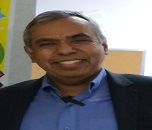Day 1 :
Keynote Forum
Timothy Barrett
University of Manchester, Bahamas
Keynote: Consultation-Liaison Psychiatry in the Princess Margaret Hospital – Nassau, Bahamas
Time : 10:00-10:45

Biography:
Timothy Barrett has graduated from the University of the West Indies in 1974 and did his General Practice until 1986. He has studied Psychiatry in Manchester, England under the supervision of Professors D Goldberg, N Kessel and E Szabadi. He received his MSc (Psych) from the University of Manchester, School of Medicine, in 1992. He has authored and co-authored several research papers. He is an Associate Lecturer at the UWISCMR Bahamas, is currently in private practice as well as Consultant Psychiatrist for the Public Hospitals Authority in Consultation-Liaison Psychiatry.
Abstract:
Consultation-liaison Psychiatry [a.k.a. liaison psychiatry, consultative psychiatry or psychosomatic medicine] is a branch of psychiatry that takes place in a general hospital or medical setting and it involves the psychiatric team in the care of persons with general medical, surgical, obstetrical and gynecological and other physical medicine diagnoses.This branch of psychiatry was formally recognized as a subspecialty in 2004 and was named Psychosomatic Medicine.In New Providence, Bahamas, consultation-liaison consults were referred to the Community Mental Health psychiatric team based at the Community Counseling and Assessment Center [CCAC]. Until January 2007 the junior medical staff was the mainstay of provision of services. However, starting the first Monday in 2007 weekly consultant teaching ward rounds were instituted and continue until the present.It has long been recognized that psychiatric factors increase the risk for the development and poor outcomes of physical disorders [Stoudemire et al.]. Prompt appropriate management of psychological problems and distress in persons diagnosed with a physical medical disorder results in lower morbidity, reduced mortality rates, reduced length of stay in hospital as well as reduced readmission rates.This retrospective study was done to assess and evaluate the referral patterns and numbers of the various departments of the general medical hospital as well as provide baseline data for establishing current and future human resource requirements for providing these services.The study also points to areas of deficiency in targeting the precise reason for referral as well as the physical medical diagnosis. Finally, the current status is described.
Keynote Forum
Inger Ekman
Umea University, Sweden
Keynote: Beyond Medicalization: Self-Injuring Acts Revisited
Time : 10:45-11:30

Biography:
Inger Ekman is a social worker with a master degree in social science. She lectures in social work and carries out her doctoral studies at the Department of Social Work and Umeå Center for Gender Science, Umea University, Sweden.
Abstract:
During the last decades self-injuring acts, the intentional destruction of one’s own body tissue without suicidal intent, have been reported as a wide-spread phenomenon among adolescents and young adults in the community. With few exceptions, scientific literature describes and explains self-injuring acts as an outcome of individual psychiatric or psychological characteristics and is concentrated on finding deviant intrapersonal patterns, gender differences, psychopathology, and emotional dissimilarities between those who self-injure and those who do not. However, the high prevalence of self-injuring acts in the community indicates the medical view to be an insufficient explanatory model that hampers the understanding of this multifaceted phenomenon. This presentation describes and challenges the medicalization of self-injuring acts, and argues a need to move research out of the medical paradigm by explicitly exploring the impact of social, cultural, structural and gendered factors on self-injuring acts. Advancement in research requires an approach beyond the limits of the medical perspective. In order to create a better understanding and a more nuanced view on this wide-spread social phenomenon, social scientific research needs to challenge the medical view and the medicalization of self-injuring acts.
- Psychosomatic Medicine | Psychiatric disorders | Psychiatry and Behavioural Science | Mood Disorders | Psychosomatic Disorders in Adults

Chair
Timothy Barrett
University of Manchester, Bahamas
Session Introduction
Sanjay Siddhartha
Dalhousie University, Canada
Title: Psychosocial Interventions in Opioid use-Where is the evidence

Biography:
Sanjay Siddhartha Worked at Horizon Health Network and Miramichi Regional Hospital. He is also an assistant professor at Dalhousie University in Canada
Abstract:
Statement of problem: Opioid epidemic is engulfi ng North America. Th e help meted out usually is embroiled in red tape. Th e
interventions most times involve mandatory counselling. Th e psychosocial interventions also may involve "right patient selection".
Methodology & Theoretical Orientation: I would like to examine the evidence for psychosocial intervention with opioid use. I
would also like to present the structure of a "low threshold clinic" in rural Canada without mandatory counselling or psychosocial
interventions.
Findings: Various metanalyses conclude that psychosocial interventions for opioid use disorder do not add to the effi cacy.Methadone
and Buprenorphine on their own, work well with opioid use.
Conclusion: Th e undue emphasis on unproven psychosocial interventions is not only unnecessary but also incurs huge cost and
distressing wait for people who need imminent help.
Spilliaert Quentin
Catholic University of Louvain, Belgium
Title: Psychosomatic regard on major depressive disorder (MDD): Family dynamics infl uences immunity in depressed patients

Biography:
Spilliaert Quentin has completed his Medicine studies from Catholic University of Louvain and has just started Doctoral studies on the Gut-Brain Axis in Major
Depressive Disorder. Besides, he is pursuing a Master’s degree in Philosophical Sciences.
Abstract:
Research on MDD involving infl ammation and immunity is currently in full stride. Stakes are multiple: Better understanding of
MDD physiopathology, discovery of MDD biological markers, and fi nding new therapeutic avenues. It has been demonstrated
that specifi c cytokine plasmatic patterns are correlated with depressive symptoms. Lymphocyte populations have also been discovered
to be unbalanced in MDD patients and well-known chronic activation of the hypothalamic-pituitary-adrenal axis in MDD has been
proved to have an impact on infl ammation and on the immune system. Hormones, cytokines, and lymphocytes balance appear to be
interacting and to work together in order to be underlying components of a sustained MDD. At the same time, it is widely accepted
that family dynamics constitute an important factor in the advent of MDD. Our aim in this study is to assess the possibility of a
statistical link between family dynamics and immunity in MDD patients. For this purpose, we prepared questionnaires assessing
depressive symptomatology and family dynamics in a MDD population. We also performed a fl ow cytometry in order to analyze
lymphocytes balance. As a result, we are able to show several signifi cant correlations between family dynamics, MDD symptomatology,
and immunity. We believe that it opens new perspectives in the understanding of the impact of family determinants on the immune
system and improve the psycho-neuro-endocrine-immune theory of depression.
Abdulrahman Al Fulaij
University of Bahrain, Bahrain
Title: Type A and B Personalities from Psychological Perspective among Medical Students
Biography:
Abdulrahman Al Fulaij obtained Post-Doctorate in Teaching of Psychology from University of Maryland, College Park, Maryland USA in 1994; PhD in Clinical and
Counseling Psychology from University of Pittsburgh, Pennsylvania, USA in 1992; MA in Experimental Social Psychology from Washington University in St. Louis,
Missouri, USA in the year 1886; BA in Public Administration, Texas Tech University, Lubbock, Texas, USA in 1979; and Diploma in Public Relations from American
University of Beirut, Beirut, Lebanon in 1975. He is working as Consultant Psychologist in Royal Charity Organization from 2006 till date. He has many publications
to his credit, some of which include: 1. Juvenile delinquency and crime: Family conditions and sociomoral development in children, Journal of Bahrain Medical
Society (2008); 2. Manual of child psychology (Arabic) (2006); 3. Attention defi cit hyperactivity and sugar consumption in children, Journal of Bahrain Medical
Society (2001); 4. Type-A personalities and heart attacks, Journal of Clinical and Social Psychology (1996).
Abstract:
Introduction: Research in the last two decades has shown that people with type A personality are astronomically competitive, selfcritical
of performances, endeavor for perfectionism in their vocations and strive toward goals in their lives without feeling a sense of
bliss. Type A individuals will eventually suff er from cardiovascular diseases and heart attacks at an earlier age compared with those
with type B personality who are more inclined to be genial, relaxed, and internally fi xated on their feelings and emotions. Th e main
objective of our study was to ascertain the prevalence of type A & B personalities among fi rst-year students who opt to study medicine.
Methods: 77 fi rst year medical students registered in the Arabian Gulf University, Bahrain during the academic year 2013-2014 were
randomly selected to be involved in the study. Students completed a pre-designed questionnaire that included measures for type A
and type B behaviors by using the Jenkins Activity Survey (JAS).
Results: Th e number of female and male students was 49 (963.6%) and 28 (36.4%) respectively. Th eir ages ranged between 17 and
20 years with mean of 17.8 years. Six diff erent Arab nationalities were represented. Th e study found that the students with type A
personality exceeded those with B [59 (76.6%) vs. 18 (23.4%)]. No signifi cant relationship was found between personality type and
other demographic characteristics except for a mild signifi cant relationship (P<0.053) with sex with more females having type A than
males.
Conclusion: Th e majority of the medical students are of type A personality betokening that such future careers, such as medicine,
require extensive commitment and are opted conventionally by students who have type A personality. It was also found that more
females have type A than B personality characteristics, a fi nding that is contrary to the prevalent understanding of the Arab-Islamic
society in the context that Arab women are oppressed and less decisive about their future.

Biography:
Inger Ekman is a Social Worker with a Master’s degree in Social Science. She lectures on Social Work and carries out her Doctoral studies at the Department of
Social Work and Umea Center for Gender Studies, Umea University, Sweden.
Abstract:
Self-injuring acts, the intentional destruction of body tissue without suicidal intent, has become frequent among adolescents in the
community. Most oft en those acts are seen as associated with intrapersonal traits such as deviant emotionality or psychopathology.
Few studies have researched the social context of the large group of adolescents who self-injure but do not present in clinical settings.
Accordingly, in research, there has been limited opportunity for those outside clinical settings to describe experiences on self-injuring
acts and its social contextual framing. In my research, I have turned to Internet published narratives written by young people who
self-injure. Such personal stories give voice to those who are seldom visible in research or in clinical settings. By listening to young
people’s own narratives of experiences of self-injuring acts, a quite diff erent picture than that traditionally shown in research emerges.
Lessons from those young people’s own narratives are that their self-injuring acts are closely related to problems in the social context
and seem to be a reaction to lack of support from adults and a response to diffi cult everyday situations. In order to enhance the
understanding of self-injuring acts, it is of utmost importance to stop focusing on individual personality traits and instead explore
the social contextual framing of self-injuring acts.
Kadhim Alabady
Dubai Health Authority, UAE
Title: Improving mental health for children in Dubai: A public health priority, mental health needs assessment for Dubai, 2015

Biography:
Kadhim Alabady, MBBS, MPH, MSc, DrPH holds a Doctorate in Public Health and Epidemiology, Master’s degree in Clinical Epidemiology (MSc) and Master’s
degree in Public Health (MPH), all from The Netherlands University with broad experience driving Research and Development (R&D) strategies and operations.
Abstract:
Background: Mental health is without doubt one of the most vital aspects of any child’s development. It is an essential part of
children’s overall health and has an impact on the child’s physical health and their ability to be successful. Mental health increases
children’s opportunity to live up to their full potential and do what is best for themselves and the people around them.
Purpose: Th is report intends to identify key challenges for mental health care for children aged 0–18 years in Dubai. It is of particular
importance to understand mental health needs and assess any gaps in care or services.
Method: A qualitative methodology approach was used. A focus group session was conducted concentrating on diff erent topics
related to diff erent mental health conditions.
Participants: Th e focus group consisted of seven mental health professionals including psychiatrists and psychologists from Latifa,
Al Jalila and Rashid hospitals with extensive knowledge about mental health illnesses, programs and services.
Setting: A single session was performed at Latifa Hospital during June 2015.
Key findings: Whilst some child mental health services exist, these are fragmented between the public and private sector. Th ere needs
to be a catalogue of comprehensive and coordinated services, which health care professionals can access to improve care delivery
and utilization of these services. Th ere is a shortage of child mental health professionals such as occupational therapists, speech
therapists, mental health nurses and psychologists. Th ere is also a need for on–going training and career development for existing
professionals. Th ere is an important need to develop and improve mental health services in the educational system that is tied in
with children’s mental health services. Th is will allow provision of eff ective and timely school interventions for children who require
special educational or supportive interventions due to mental health issues.
- Applications of Psychosomatic Medicine | Consultation-Liaison Psychiatry | Educational Psychiatry | Treatment of Psychosomatic Disorder

Chair
Sanjay Siddhartha
Dalhousie University, Canada
Session Introduction
Erik Matser
Cornell University, Netherlands
Title: Talent identifi cation and talent optimization

Biography:
Erik Matser has completed his PhD from Maastricht University (2000) and from New York (Cornell University). He is the Director of the Polikliniek Neuropsychologie, a clinic in Netherlands, focused on the treatment of post-concussion syndrome and post whiplash syndrome. He has published more than 15 papers in reputed journals and has been serving as a Member of the Dutch Health Council regarding the topic brain injury in young people.
Abstract:
Talent identification and talent optimization are important topics in the world of sports, music and business. It has been proven that practice leads to better accomplishments and that, due to practice otherwise known as deliberate practice, actual changes occur in the brain. Th is fact has become known as the ’10 year rule’: training or practicing during the course of a period of 10 years
cause a signifi cant improvement in accomplishments and with that also changes in brain tissue. However, if all team members live and train in the same context i.e. each following the same amount of training time as well as the same eating pattern and each spend equal amounts of time sleeping, how is it possible that one member achieves a higher level of performance than the other. This article will not only shed light on the learning processes that improve performance, it will also present an idea (or defi nition) of what talent
is. Talent is the explanation for why some achieve more than others (under the same learning conditions). Top-talents present with an extraordinarily high standard of cognitive skills, primarily in the areas of visual information processing speed and workingmemory. Aside from these cognitive skills, the motivational profi le of these top-talents was also mapped. It seems that they have certain personality traits at their disposal which enable excellent achievements. In combining excellent cognitive skills with a specific
motivational profi le, the chances of success are increased. Identifying and optimizing top-talent is a unique process in which clinical neuropsychology seems to be gaining a role of ever increasing importance.Conclusion To belong to the best in the world and to be able to compete with them, several ingredients can be extracted from the nature-nurture discussion which seem essential in predicting success. Although many hours of specifi c training focussed on changing brain tissue are necessary to achieve a certain skill, it seems that intellectual, cognitive and congenital characteristics play an equally
important part. Neuropsychological research demonstrates this point, using questionnaires and semi-structured interviews. When people with certain skills (talent) are selected, a training programme should be carried out which will support optimal development of brain tissue, which in turn will optimize the functionality of the skill system being trained. With this in mind one should base one’s conclusions on the principles of scientifi c literature on learning. A clinical talent identifi cation and talent optimization neuropsychologist can be deployed when identifying and optimizing talent as well as composing a specific team culture and aligning different characters to form the most desirable combination for a top-class team.
Lolowa A. Al Mekaini
United Arab Emirates University, UAE
Title: Expressive Language Screening of Preschool Children in United Arab Emirates
Biography:
Lolowa A Al Mekaini works to integrate her professional experience to achieve evidence based best practice standards. Her mission is to meet the expectations
of UAE students, patients and stakeholders in providing high quality medical care across the Emirate. This message was communicated through multiple
communication forums, teaching, patient and staff education, competency development, and the engagement of workforce. Her passion focused on wellbeing of children and related research’s. She holds the position of Co-Director for the Al Ain Family Medicine Residency Program (2004-2010) and Family Medicine Consultant in Pediatric department at UAE University (recently). She is practicing as a Family Medicine Consultant. She was assigned to Regional Director of Ambulatory Health Centers (2012-2014). This includes management oversight of thirteen ambulatory clinics across the Eastern region of Abu Dhabi- UAE.
Abstract:
Language disorders in United Arab Emirates’ (UAE) children are underdiagnosed and their impact on children’s behavior and
emotional development is oft en overlooked. Th e aim of this study is to evaluate expressive language development in UAE preschool
children and its correlation with behavior syndromes. Total of 152 UAE toddlers (18-35 months of age) participated in the study. Two screening instruments developed by the University of Vermont were adapted linguistically and culturally before being used for data collection; (1) Language development survey for age 18-35 months; and (2) Child behavior checklist for ages 1.5-5.
Th e informant was the mother (76%). Majority of all informants were females (53%). Th e mean age (SD) of the enrolled children was 25.9 (4.8) months (median 25.9). Th ere were no signifi cant diff erences in the total vocabulary scores according to the source of information (p=0.4). No signifi cant diff erence in the total vocabulary scores (Fig.1) was found between males and females (p=0.3). The vocabulary count was signifi cant higher in females at all age groups: (56.1%, p=0.05) for body part, (69.9%, p=0.064) for places and
(53.9%, p=0.08) for clothes. Food and actions words were recorded with a higher frequency (Fig. 2). Percentage of normal vocabulary percentile score decreased with increasing age. Around 50% of children in all age group had a minimum normal vocabulary count (Table 1).Premature birth (14.9%) and a positive family history of language delay (16%) were associated with a 10% lower vocabulary score (p=0.07 and 0.09, respectively). There was a signifi cant correlation between total vocabulary scores and behavior outcomes
(externalizing syndrome, attention defi cit hyperactivity problems, and oppositional defi ant problems, p<0.001). Externalizing and oppositional defiant abnormalities were associated with a higher vocabulary score. This cross-sectional community-based study is the first objective assessment of UAE pre- school expressive language development.

Biography:
Timothy Barrett has graduated from the University of the West Indies in 1974 and did his General Practice until 1986. He has studied Psychiatry in Manchester, England under the supervision of Professors D Goldberg, N Kessel and E Szabadi. He received his MSc (Psych) from the University of Manchester, School of Medicine, in 1992. He has authored and co-authored several research papers. He is an Associate Lecturer at the UWISCMR Bahamas, is currently in private practice as well as a Consultant Psychiatrist for the Public Hospitals Authority in Consultation-Liaison Psychiatry.
Abstract:
Physician leadership is very important, especially in the health care services industry and hospitals. Traditionally the doctor or physician was the acclaimed leader who the rest of the staff , the community and the political directorate looked to and depended upon for vision and guidance in setting up clinical as well as community programs for the nation’s health. Gradually, over the past 30 or so years, the business of medicine has emerged which requires a diff erent knowledge base and skill set which the physician lacks and so the shift to non-physician administrators began and continues. For us as physicians, to address this reality is crucial to re-establishing physician leadership that is effective and focuses on the issues we know to be most important to our patients and the health of the communities we serve. Th is speech addresses some basic flaws and failings but also makes suggestions as to how we can become the effective physician leader for today.
Ayaa Siddig Abdelrahman Ali
University of Khartoum, Sudan
Title: The Nature and Prevalence of Psychiatric Disorders in a Sudanese Juvenile Correctional Facility
Biography:
Ayaa Siddig Abdelrahman Ali is a Medical graduate and has graduated in 2016 with the Bagdadi prize for best overall academic performance and Lord Kitchener’s prize for best academic performance in the sixth year of medical school along with other academic prizes.
Abstract:
Background: High morbidity of mental disorders among juvenile off enders has been confi rmed by several studies, thus challenging both the juvenile justice system and the mental health system. Data from developed countries may not refl ect the situation in lowincome countries and therefore cannot form a basis for intervention. No similar study has been done in Sudan.
Objective: To determine the prevalence of psychiatric disorders among incarcerated youth in Al-Juref juvenile correctional facility.
Method: All juveniles (forty eight) were studied utilizing a descriptive cross-sectional study design. Data was collected by the principal investigator using a socio-demographic questionnaire and the MINI-KID 6.0. Data was analyzed using the Statistical Package of social sciences program v.20.
Results: Most respondents were males (46) with a mean age of fi ft een (±1.6 years SD). Most were living with both parents (75%) and were school dropouts (41.7%). Th e majority were arrested for theft (33.3%) and rape (29.2%). Prevalence of psychiatric disorders was high (60.4%) with conduct disorder (CD) being the most common (47.9%), followed by anxiety disorders (31.1%) and major depressive disorder (14.6%). Comorbid psychiatric disorders rate was high (31%). Even aft er subtracting CD, prevalence was still
common (39%).
Conclusion & Recommendations: New information can help mental health providers and policy makers in the juvenile justice
system make eff ective interventions in provision of mental health services. I recommend clinical assessment for juveniles when they
appear at court and training of workers in the justice system on how to detect features of psychopathology.

